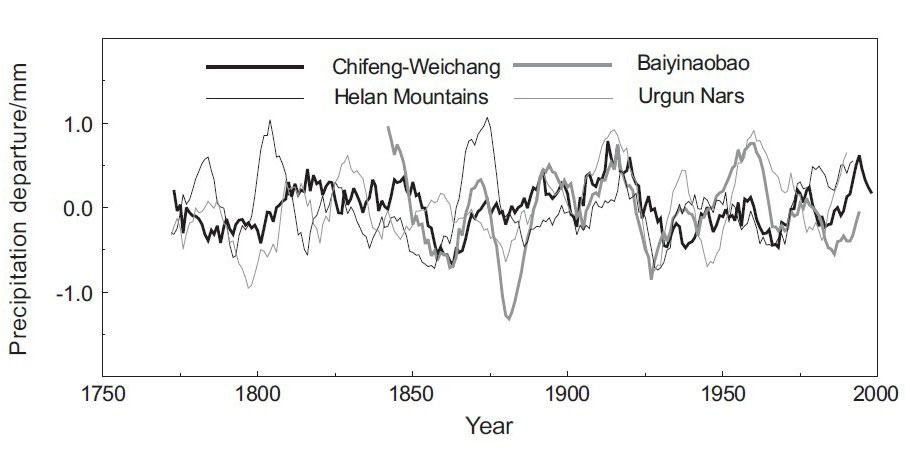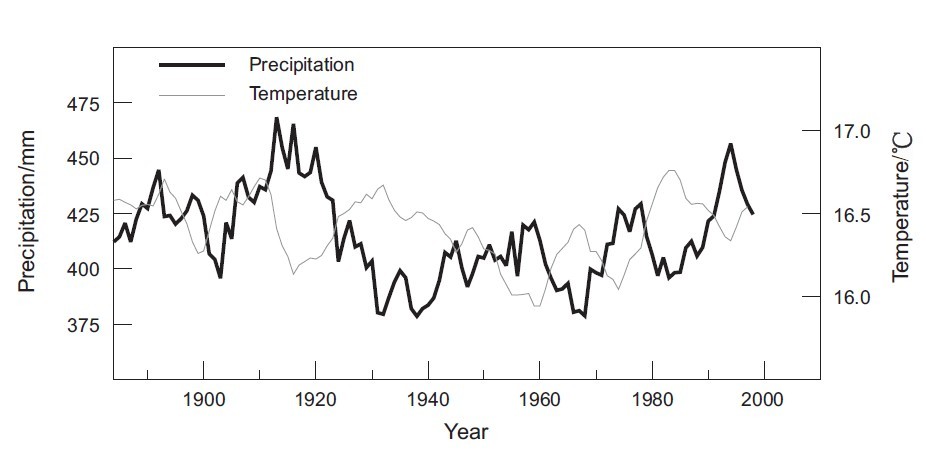
Fig.1 Comparison of the precipitation departure within Chifeng‐Weichang, Helan Mountains, Baiyinaobao, and Urgun Nars (Mongolia). Four curves are smoothed by an 11 year moving average. The horizontal line is the zero line(Credit to Dr. Liu Yu et al.).

Fig.2 Comparison between the prior August to current July precipitation and May to June mean temperature of Weichang. Both curves are smoothed by an 11 year moving average(Credit to Dr. Liu Yu et al.).
The environmentally sensitive zone of northern China is a transitional zone between semi-arid to arid conditions, monsoon and non-monsoon climate, forest and steppe, as well as between agriculture and husbandry. Under the inappropriate human interferences, the environmentally sensitive zone has been obsessed with eco-environmental degradation, environment degeneration and even becoming the new sandstorm resources in recent years. Located in the water conservation area and the upwind direction from Beijing-Tianjin region and Northeast China, Chifeng-Weichang region is representative of environmental sensitivity and vulnerability. Recently, its dust events have already threatened the eco-safety of North China and Northeast China. Therefore it is critical to understand the processes and mechanisms of climate changes in this zone for studying any environmental issues associated with the zone.
Prof.Liu Yu of Institute of Earth Environment,CAS and his group have recently reconstructed the total precipitation of previous August to current July for the past 236 years and the mean temperature of current May to June from 1884 to 2002 on the basis of the Pinus tabulaeformis ring widths from four sites in Chifeng and Weichang regions, China. And the results show that:
1. A significant negative correlation is found between the two reconstructions in this study for the common interval 1884~2002, which suggests the dominant climate regime in the study region is either cool/wet or warm/dry.
2. The reconstructed precipitation series is in good agreement with tree-ring-based reconstructions from Baiyinaobao, Helan Mountains or even the State of Mongolia. A similar trend was also found between the reconstructed temperature series of Weichang and that of Nanwutai region and the Asian-Pacific PDO (Asian-Pacific Decadal Oscillation Index). Both of the two reconstructed series are significant correlated with the average dryness/wetness index of Datong and Beijing, which suggests probable comparability of climate variation in a large-scale spatial frame
3. Precipitation in study area is dependent on the East Asian summer monsoon strength, and the variations of the East Asian summer monsoon on decadal scale are coincident with the other regions within the environmentally sensitive zone of northern China for the past 236 years, as well as Mongolia.
Related paper is published in the Journal of Geophysical Research, VOL. 115, D06103, 9 PP., 2010 doi:10.1029/2009JD012330.
 © 2015 Institute of Earth Environment,CAS
© 2015 Institute of Earth Environment,CAS Address:No. 97 Yanxiang Road, Xi'an 710061, Shaanxi, China

 Location :
Location :